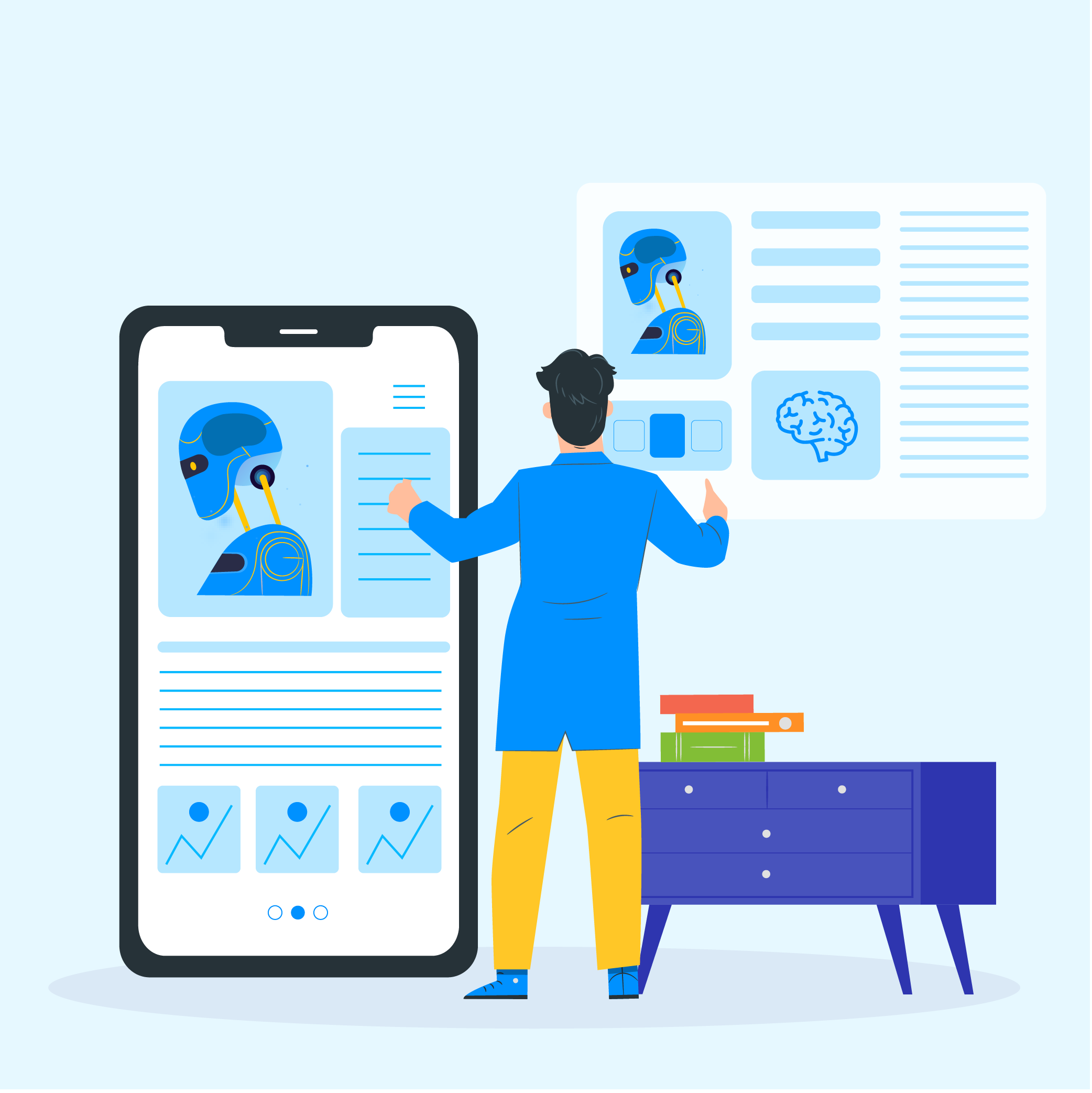Appinventiv’s Guide to Shaping Your Digital Transformation Strategy
Digital transformation is changing the world we are operating in. New technologies have led to the creation of new markets, which in turn have created new competitors and customers. These competitors and customers are together creating new expectations. To ace the digital world, businesses should not just offer superior experiences but deliver their promise in a nimble manner. The benefits of getting sound digital transformation consulting is immense. Especially for the one that understands the need for fast digital transformation with downtime.
Out of the fear of getting irrelevant, businesses have started leaning towards digital transformation services without completely understanding the depth of the concept. Here at Appinventiv, we help businesses understand that digital transformation is a lot more than simple technological adoption. We help them get a grasp of how their customers have evolved, the digital journey their competitors are on.
Here’s the in-depth guide that we pass towards our clients before we hand-hold them towards their digital business transformation.
Table of Content
- What is Digital Transformation (DX)
- What Causes Digital Disruption?
- The Key Elements of Digital Transformation
- Appinventiv’s Three Step Digital Transformation Framework
- Failure Stories of Digital Transformation a.k.a Learnings from Businesses That Tried
- How We Measure the ROI of Digital Transformation-Directed Efforts?
- Popular but ‘couldn’t be further from the truth’ Myths About Digital Transformation
What is Digital Transformation (DX)
The definition of digital transformation, as opposed to what is known as moving businesses to apps and websites, is different for every business and industry. In generic terms, we can define the concept as integration of digital technology in every business area that changes how businesses operate and deliver value to their customers.
When we look deeper inside, achievement of digital transformation goals can be seen as a cultural change that makes businesses get comfortable with failure or sometimes even let go of the business practices that they had been following traditionally, in order to welcome new-age practices.
There are a number of benefits of digital transformation adoption –
- Better customer experience
- Reduced operation cost
- Accurate segmentation of market
- Greater access to data and analytics
- Launch of new products and services.
In addition to these perks, there are several goals that businesses seek to achieve at the back of their digital transformation efforts
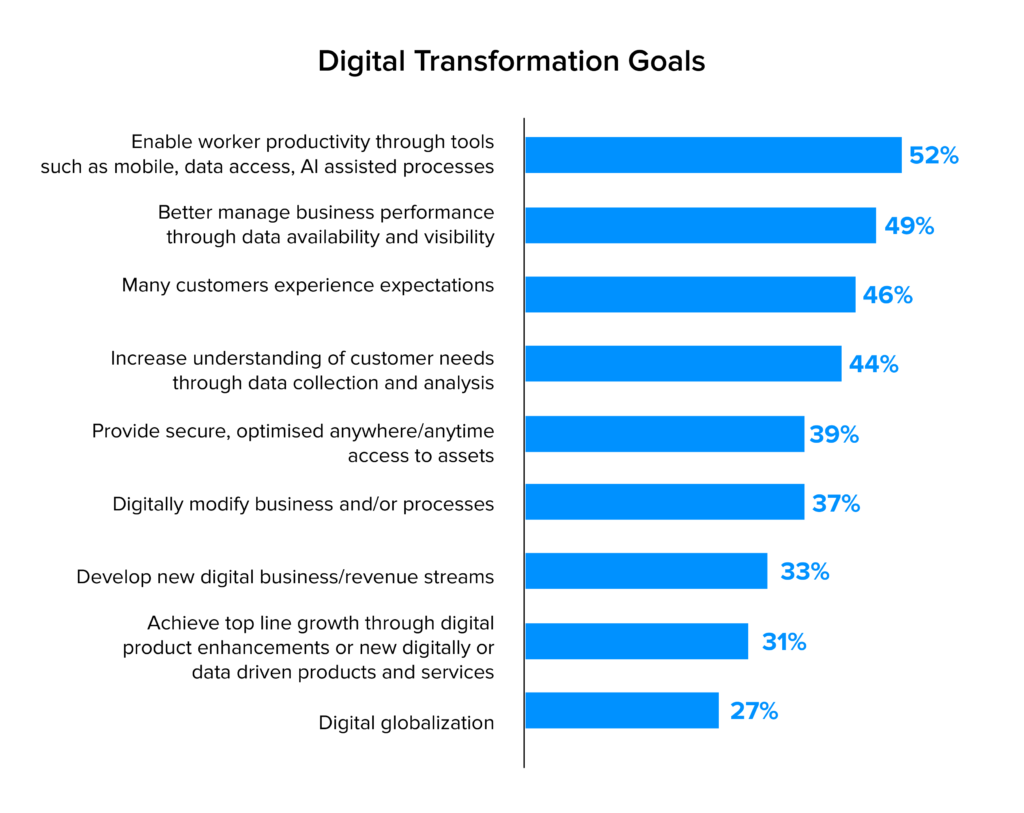
Although the coronavirus driven fast tracked shift to digital is seen as the reason behind the growing focus on digital transformation trends, the causes started coming on the surface much before the pandemic.
What Causes Digital Disruption?
Technical innovations: A series of technologies with obvious transformation abilities like AI, IoT, and Blockchain are the first cause of digital transformation for businesses. It is not these technologies that drive transformation but how they are being adopted by government, businesses, and customers to offer newness.
Customer demands: Customers’ needs and demand are not wholly dependent on technical innovations. They can be driven by societal changes, new trends, changed way of interacting with a business, amongst a number of other driving factors.
The fact that customers are at the center of business efforts and value offerings, their changing needs also becomes a primal cause why businesses seek digital strategy consulting firms.
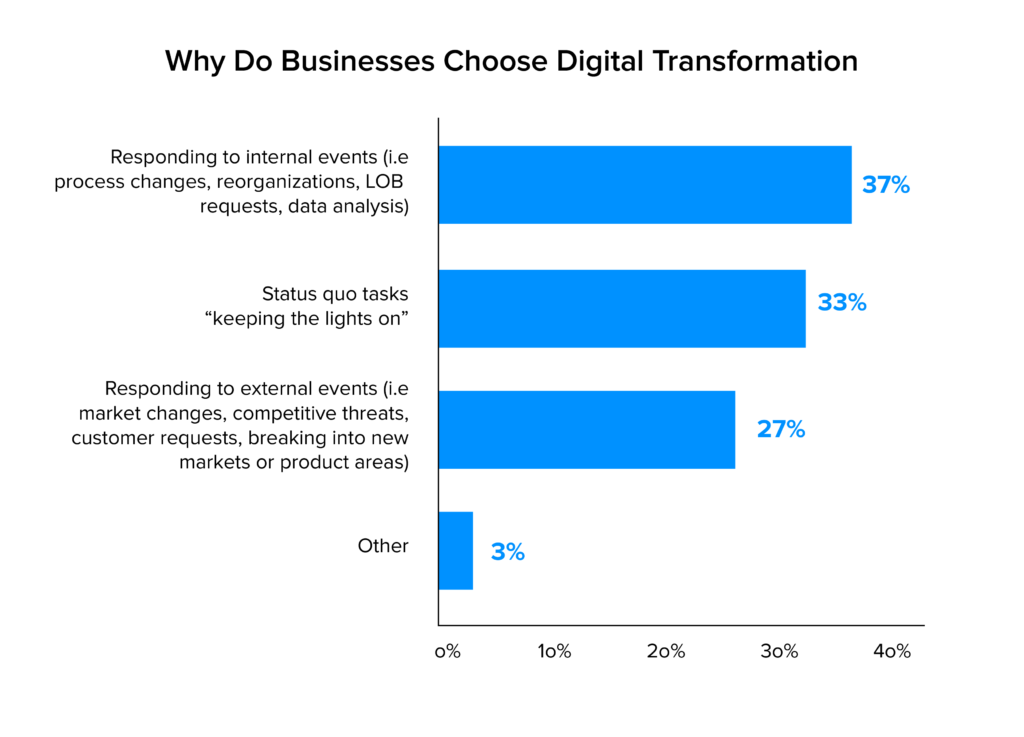
Ecosystem changes: Companies are a part of much broader ecosystems – business and social. Demand from stakeholders for adopting, collaborating with transformational businesses are some of the examples of business ecosystems. Regulatory changes, political changes, natural disasters, or pandemics are a part of social causes that can demand businesses to digitally transform.
The Key Elements of Digital Transformation
Customer experience
Digital transformation drives customer experience towards ultimate brand resonance. This is not a secret anymore. Businesses across sectors are using digital platforms for gaining insight into customers’ needs, using technologies to communicate directly with their customers, and inherently transforming customers’ touchpoints.
Here are some of the ground-level ways businesses are digitally transforming their customers:
- Personalizing the customer journey
- Seamless omni-channel presence
- Embracing automation to keep customers updated.
Operational Processes
Digitalization of processes lowers the amount of resource and time needed for maintaining operations and innovating. Companies are enabling workers with digital tools and platforms for improving collaboration on the go, while using digitalization tools for streamlining their operations through data capture and analysis automation.
Business Model
Modification of business models also acts as a key element of digital transformation. While a number of traditional businesses are shifting to digital platforms to change their offerings, there are a number of other businesses which are simply adding new digital-centric models in their business offering.
Knowing the elements where digital transformation can be seen at its peak is not sufficient for businesses seeking practical ways to integrate disruption. If we had to put a number to it, 80% of our digital transformation clients come to us seeking a framework that they can apply in their business to make digital transformation a journey for their internal and external stakeholders. A successful implementation of the framework lies at the center of defining the benefits of digital transformation.
Appinventiv’s Three Step Digital Transformation Framework
Our digital transformation roadmap is designed to give business leaders a starting point. They act as a checklist of what needs to be done and a sequence of steps which have to be taken. If we had to list down the differentiating points between our framework and ones popularized by other digital transformation companies, we would highlight their role in:
- Helping executives see the bigger picture
- Drilling down the concept to a stage where we talk in tasks and sequences
- Transformation of back and front office
- Being customized according to every business precise needs.
Step 1: Understand Industry-Specific Digital Disruption Opportunities
Digital business transformation solutions impact industries differently. Even though it creates opportunities that enable businesses to adopt alternative business models, every industry requires a different transformation approach.
While we advertise digital innovation led by mobile apps, Internet of Things, AI, Blockchain, etc to every business, the use cases differ. For example, Healthcare can make use of digital transformation accelerating technologies to solve insufficient access, while manufacturing domains can use it for correcting the yield vs. labour cost differences and banking domains can use them for blurring geographical boundaries.
Two key stages of our digital transformation consulting services: product discovery workshop and kickoff meeting starts with identifying the challenges that are unique to every industry and finding use cases for disruptive technologies to solve those challenges.
Step 2: Create a Customer-Centric Business Strategy
Beneficial digital transformation efforts begin with customers. They are, from their essence, built for delivering great customer experience.
When we talk about putting customers-first, we make businesses understand how modern customers, loaded with the power of digital technology on one hand and wealth of information on the other, compare, shop, and share.
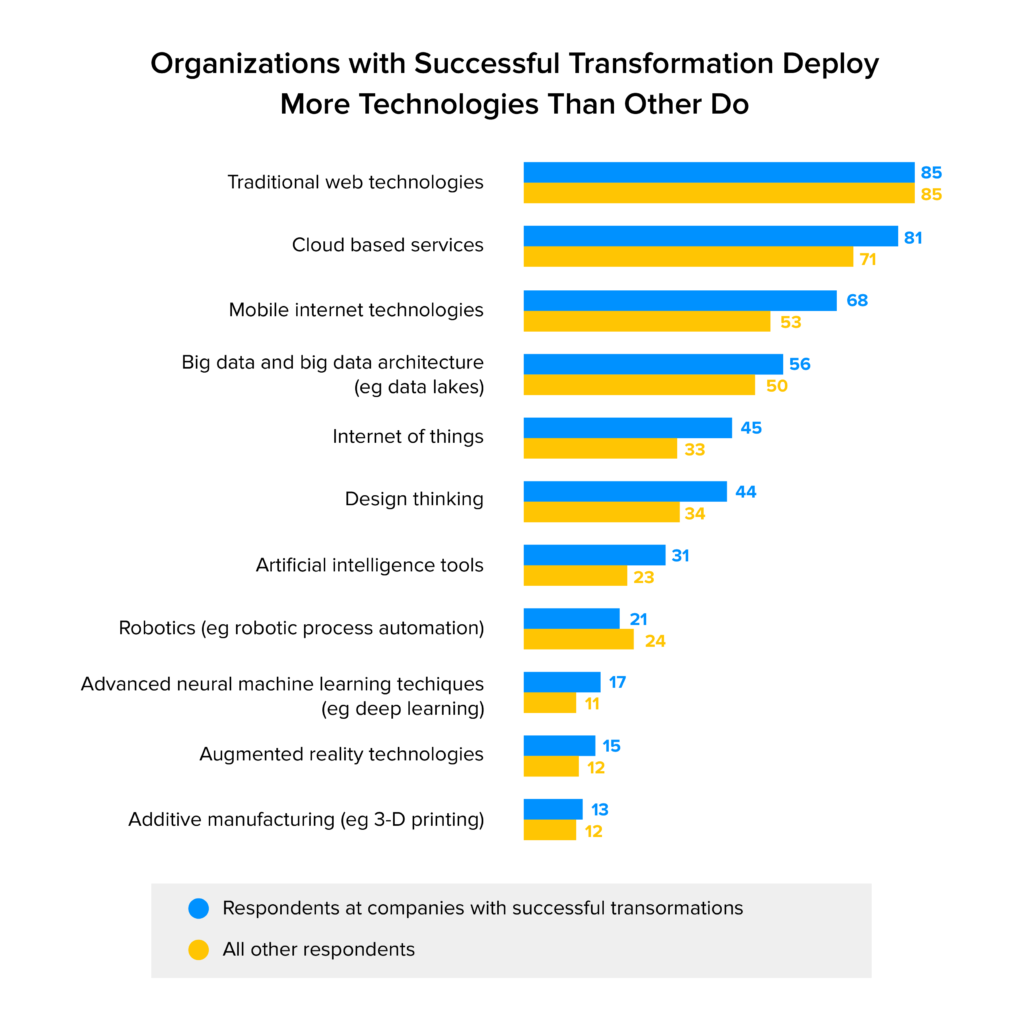
Our first step of action is to bring businesses on the platforms their customers are on and availing them with technologies that their customers are making use of. We create a framework for them to capture, analyze, and act upon the insights captured from customers’ data.
During this step, we draw a line to where businesses overdeliver against their customers expectations or the point where delivering customer service blurs the cost at which it comes. We help businesses understand their customers and the speed at which their needs change. This helps us reduce the cost of over delivering while enabling businesses to create value that meets their customers’ needs.
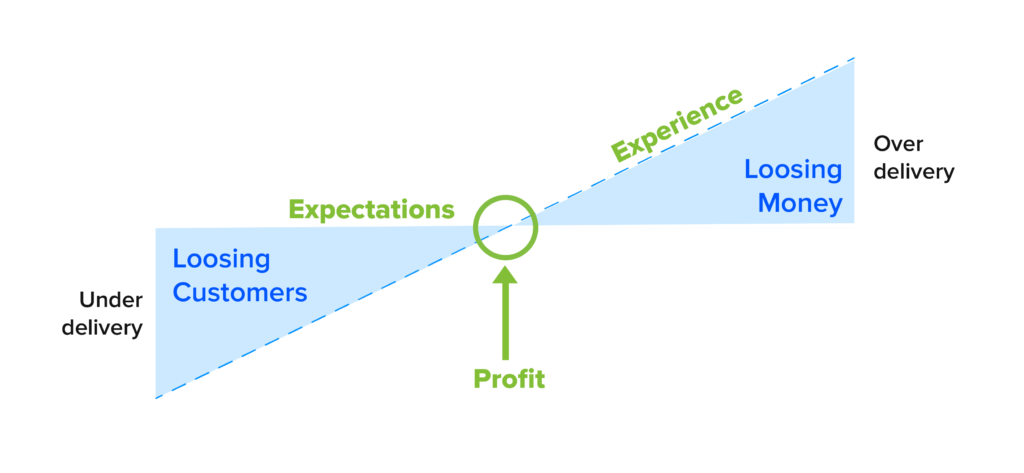
Step 3: An Enterprise-level Strategy Which Connects Back, Middle, and Front Office
Appinventiv professionals strongly believe that in order to fully realize the potential of digital transformation, it is important to not just add it in platforms which act as customer touchpoints but also in supply chain, IT, operations, finance, and human resources.
Here’s how we translate into the front office – We help businesses identify the services, products, and business models which do not contribute to better customer experience. We incorporate tools and processes built on AI driven data capture and analytics for tracking and anticipating customers behaviour in real time while offering them personalized experiences and products.
In the middle office, the transformation stage looks at delivering superior experience to employees. We use our enterprise app development expertise to develop solutions that better connectivity, improve transparency and agility, and lower friction.
Above all, we create digital solutions that connect the middle office with the front and back office.
Lastly, in case of back office, our efforts in back office digital transformation revolves around bettering automation, abandonment or modernization of legacy systems and creation of a more scalable IT system that is built on the cloud ecosystem. Most importantly, we concentrate on making back office an enabler in offering real-time data which supports predictive actions.
In addition to these steps, we take measures to help our partners understand that digital transformation is not a one-off step but a continuous journey. And although our role as one of the trusted digital transformation consulting companies ends here, their’s continue in the face of helping their employees understand the need of digital transformation and bringing a change in the work culture.
After everything’s said and done, when working on these steps, we always keep ourselves on our toes to ensure that our clients do not become one of the failure stories of digital transformation.
Failure Stories of Digital Transformation a.k.a Learnings from Businesses That Tried
There is no surprise that digital transformation comes with challenges – one that goes beyond outsourcing digital transformation. There can be organization wide resistance towards change, uncertainty in terms of what customers need, presence of legacy systems, focus on process optimization keeping business model innovation on the backseat. The list can go on for ages.
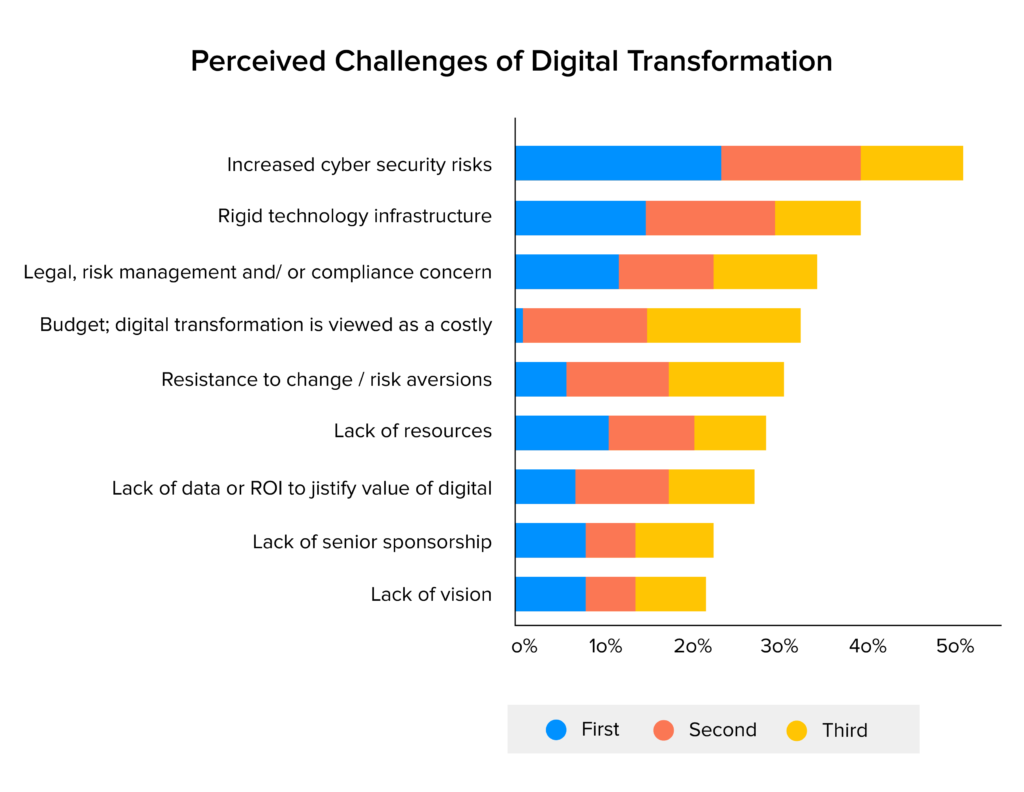
There are many well-known businesses with the best digital transformation consultancy agencies at their disposal that have today become some of the biggest failure lessons of the world. Let us peek into what went wrong for them and what learning we can draw from their mistake.
1. Blockbuster – CEO John Antioco, as a response to Netflix’s growing demand, funded a challenger service known as Total Access. The board thought of the move as an expensive one and fired John Antioco while reversing his changes.
Lesson: Ensure your board has your back in a digital transformation project.
2. Xerox – With its main platform falling in the pit of low demand, the company came up with a new secretarial machine designed to be automated, which was way ahead of its time.
Lesson: Focus on the timing.
3. Kodak – When the brand’s revenue magnet – developing film – lost demand, the company which was once at the top of the photography equipment industry filed for bankruptcy in 2011.
Lesson: Realize the digital capabilities and transform before the business model dies.
A key lesson that we draw from these failure stories is the need to have a measure set up for measuring the return on investment. But it is a lot easier said than done.
How We Measure the ROI of Digital Transformation-Directed Efforts?
In order to validate digital transformation success, we always ask our partnered business leaders to quantify the returns on investment. We understand that the nature of digital transformation is to be evolving and ongoing, which means that traditional business calculations and financial governance methods can be less effective. But quantifying success is mandatory for continued investment.
Here’s Appinventiv advice on how to approach measuring digital transformation solutions success –
When gauging how the digital transformation investments are performing, take a portfolio view in place of a project view. Imagine yourself as a venture capital firm and look at the overall performance for determining how things are going in place of noting the difference project-by-project. In addition to this:
- Set the initial level metrics before applying digital transformation changes
- Build micro-metrics for an agile environment
- Add in business outcomes like LTV, time to market, operational effectiveness, and cost benefit analysis.
Up until this point, we have looked into digital transformation adoption in a business context from multiple facets. However, the one thing that can put all these efforts into vain is believing popular myths that surround digital transformation. Let us look into what they are as a parting note for today.
Popular but ‘couldn’t be further from the truth’ Myths About Digital Transformation
1. Business transformation is all about technology
Although technology plays a massive role in making a company a digital brand, the DX process is an endless mix of user-specific process. At its crux, it is about bringing businesses to a point where they understand their customers’ needs and market in a way that they are able to benefit from trends before their competitors.
2. You will have to launch a new product
Businesses don’t necessarily have to launch an app or create a new website to make their digital customers fall in love with them again. They can also revisit their offering and marketing communications, ensuring that they are aligned with the modern day customers. A simple tweak in certain business aspects can also play a huge role in offering impactful user value.
Digital transformation has crossed the stage of being a trend. It has now become a mode to gain competitive advantage. I hope that this guide helped you view the complex process as actionable steps. In case you want to learn more, reach out to our digital transformation team.

strategies your digital product..
